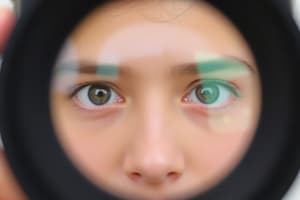Podcast
Questions and Answers
What is astigmatism?
What is astigmatism?
A refractive condition in which a point focus of light cannot be formed on the retina due to multiple foci caused by variation in powers in the different meridians of the eye.
Who was the first to correct astigmatism by using a spherocylindrical lens?
Who was the first to correct astigmatism by using a spherocylindrical lens?
- John Green
- Thomas Young
- H.Knapp
- George Biddle Airy (correct)
Corneal astigmatism is characterized by the cornea exhibiting a variation of curvature throughout the different __________.
Corneal astigmatism is characterized by the cornea exhibiting a variation of curvature throughout the different __________.
meridians
Irregular astigmatism is when the curvature of the cornea is uniform and at right angles to each other.
Irregular astigmatism is when the curvature of the cornea is uniform and at right angles to each other.
Match the following types of astigmatism with their descriptions:
Match the following types of astigmatism with their descriptions:
What is presbyopia?
What is presbyopia?
At what age does presbyopia commonly occur?
At what age does presbyopia commonly occur?
What is the etiology of presbyopia?
What is the etiology of presbyopia?
What is incipient presbyopia?
What is incipient presbyopia?
What is absolute presbyopia?
What is absolute presbyopia?
Flashcards are hidden until you start studying
Study Notes
Astigmatism Definition and Characteristics
- Astigmatism is a refractive condition where a point focus of light cannot be formed on the retina, resulting in multiple foci.
- It occurs due to variation in powers in different meridians of the eye.
Historical Background
- Thomas Young: had a crude measurement of his own astigmatism (about 1.75 D).
- George Biddle Airy: first to correct astigmatism using a spherocylindrical lens (USA, 1828).
- John Green: produced the first distance test chart for astigmatism, including the clock dial chart.
- H. Knapp: credited with the first trial case containing cylindrical lenses and suggested the method for locating the axis.
Classification of Astigmatism
- Total Astigmatism: the sum resultant astigmatism of all factors of the refractive system.
- Corneal Astigmatism: variation of curvature throughout different meridians of the cornea.
- Lenticular Astigmatism: astigmatism due to unequal curvature of lens surfaces or layers.
- Resultant Astigmatism: in relation to the total refracting system.
Regular and Irregular Astigmatism
- Regular Astigmatism: each meridian of the cornea is uniform, with two principal meridians at right angles to each other.
- Irregular Astigmatism: curvature is not uniform, and principal meridians are not at right angles to each other.
Types of Corneal Astigmatism
- Direct/With-the-Rule: curvature of greatest power near the vertical meridian (60-120°).
- Inverse/Perverse/Against-the-Rule: curvature of greatest power near the horizontal meridian (0-30°, 150-180°).
- Oblique: greatest power and least power lies within 30-60° and 130-150°.
Lenticular Astigmatism
- Regular: principal meridians at right angle to each other.
- Irregular: principal meridians not at right angle to each other.
Resultant Astigmatism
- Compound Hyperopic Astigmatism: two principal meridians fall beyond the retina, corrected with plus sphere and plus cylinder.
- Simple Hyperopic Astigmatism: one meridian falls on the retina, and the other falls beyond the retina, corrected with simple plus cylinder.
- Compound Myopic Astigmatism: two principal meridians fall in front of the retina, corrected with minus sphere and minus cylinder.
- Simple Myopic Astigmatism: one meridian falls on the retina, and the other falls in front of the retina, corrected with simple minus cylinder.
- Mixed Astigmatism: one meridian falls behind, and the other falls in front of the retina, corrected with one sign combined with an opposite sign.
Signs and Symptoms
- Symptoms: blurred vision, transient blurring, frontal and temporal headaches, tearing, and smarting.
- Signs: tilting of the head, squinting, wrinkling and furrowing of the brows, and holding reading material too close.
Refractive Status of Children
- Pre-school years: globe increases by 5mm on average between birth to 3 years.
- School years: increase of 1mm axial length from 3-13 years old.
- Myopia: develops around 5-6 years old and may remain or increase.
- Hyperopia: develops around 5-6 years old, with +1.50 D hyperopia remaining.
- Spherical refraction (+0.50-+1.25 D) at 5-6 years old may lead to emmetropia at 13-14 years old.
- Prevalence of myopia is lower in rural regions compared to urban regions, supporting environmental exposure's impact on myopia development.
Presbyopia
- A refractive condition where the near point of accommodation recedes due to advancing age, making it difficult or impossible to see at near without corrective lenses.
- Often occurs between 38-40 years old, but can appear as early as 40 or as late as 48-50 years old.
- Not a disease, pathological condition, or anomaly, but an expected and inevitable part of the healthy aging process in humans.
Accommodative Insufficiency
- Definition: Difficulty or inability to see at near due to the receded near point of accommodation.
- Commonly associated with presbyopia.
Etiology of Presbyopia
- Caused by changes in the crystalline lens, affecting accommodation.
Classification of Presbyopia
- Incipient Presbyopia: Early stage of presbyopia.
- Absolute Presbyopia: Amplitude of accommodation is decreased.
Studying That Suits You
Use AI to generate personalized quizzes and flashcards to suit your learning preferences.





